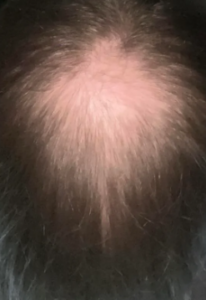Dihydrotestosterone (DHT) inhibitor finasteride was first approved by the US FDA to treat hair loss in 1997. The original brand name from its US based manufacturer Merck was Propecia.
The only other drug that has ever been approved by the FDA to treat hair loss is topical minoxidil (brand name Rogaine). In Japan and South Korea, dutasteride has also been approved to treat hair loss.
Long-Term Finasteride Studies

Although finasteride was approved to treat hair loss 26 years ago, there are very few studies in existence that even attempt to analyze 10-year results.
It is extremely difficult to get hair loss sufferers to come back to the same clinic regularly for 10 years and have their scalps analyzed. Moreover, many patients tend to stop using the drug after some years due to side effects or loss of motivation. Some might also alter their dosage without consulting their physician.
Many hair loss patients also add other drugs and products into the mix. This makes it impossible to determine the exact solo impact of finasteride on their hair.
The image on the right is from a Japanese patient who is taking finasteride for his hair loss. It shows the results at first visit, followed by annual follow-up visits from years 1 through 10. He is part of a long-term study of 523 Japanese patients who took 1 mg/day finasteride to treat their androgenetic alopecia for 10 years.
According to the authors of this study:
“A high objective efficacy was demonstrated by the modified global photographic assessment score (MGPA). It revealed improvement and prevention of disease progression in 99.1% of the 532 Japanese men with AGA treated with 1 mg/day finasteride for 10 years.”
Amazingly, these Japanese men continued to see new hair growth even after years of finasteride 1 mg/day use. In fact, many patients even saw new hair growth at the 10 year mark! Furthermore, most patients saw an improvement from year 5 to year 10.
The average Japanese androgenetic alopecia (AGA ) patient in this study saw an improvement of approximately 1 Norwood Scale grade after 10 years of treatment with Finasteride. Side effects remained minimal even after such long-term use. I am surprised at such a high 99.1% success rate after 10 years. It is beyond amazing.
I always assumed that the human body develops some tolerance to finasteride (just as with repetitive use of antibiotics, alcohol etc.) after 10 years use. Moreover, finasteride only reduces serum DHT levels by 70% (and scalp DHT levels by 64%). Surely the other 30% keeps causing some damage to hair follicles?
Online anecdotal reports suggest that a majority of long-term finasteride users seem dissatisfied in the long run. Perhaps the first point below explains this anomaly.
- Do note that these same authors published an 801-person (5-years of finasteride use) study in 2015 that concluded that Japanese hair loss sufferers are much better responders to finasteride than are Caucasian men. For comparison, they cited a prior large-scale 1,553 person study on Caucasian men that showed a 48% improvement after 5 years. Nevertheless, Caucausian men are still great responders after 5 years. The same authors also did a 2.5-year report (3,177 patients) with similarly favorable results in Japanese men. A summary of their 2.5-, 5-, and 10-year results can be read here.
- In 2011, a team from Italy published 10-year results of 1 mg/day finasteride use in 181 men. The overall results were also quite favorable in this report, although there were some significant diffference between various age groups of patients. After 10 years, almost 70% of patients who experienced growth in their first year experienced continued growth. Moreover, in 21% of cases, treatment continuation beyond 5 years provided even better results. All the more resons to not give up on finasteride if you are seeing no side effects.
According to Dr. Robert Bernstein:
“Although finasteride will usually continue to work as long as you take it, it may lose some of its efficacy over time. Generally after about 5 years we may notice that the patient’s hair is starting to thin again and we will increase the dose slightly.
However, he cautions that even if someone keeps thinning while on finasteride, it does not necessarily mean that the medicine is not working. The same person might have thinned much more without taking the drug.
20 Year Results
I hope that our Japanese friends maintain their discipline and release a fourth study with 15-year results by 2025. I doubt that we will ever see anyone pubish 20-year results, but hope I am wrong. In the invaluable ongoing Japanese effort, the dropoff in patients counted from 2.5 to 5 to 10 years of follow-up was 3,177 to 801 to 523 respectively. By the 20 year mark, I do not expect more than 100 people will have returned each year, even if photos are taken remotely.
Based on the findings that I discussed in this post, I am encouraged to keep using my dutasteride (which is superior to finasteride and has a much longer half life). However, I just take one 0.5 mg pill every week due to a fear of side effects. I also wonder if the long-term effects of finasteride (and dutasteride) on estrogen and testosterone levels are harmless.
Make sure to also check out my past posts on finasteride and dutasteride dosage discussion; and on finasteride and low-dose dutasteride combination treatment.

